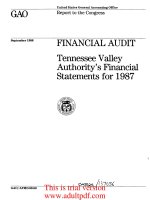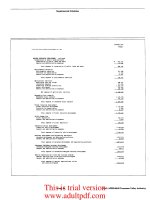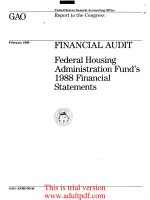REPORT TO THE MARYLAND GENERAL ASSEMBLY CLASS SIZE IN MARYLAND PUBLIC SCHOOLS 2016-2017 SCHOOL YEAR
Bạn đang xem bản rút gọn của tài liệu. Xem và tải ngay bản đầy đủ của tài liệu tại đây (791.8 KB, 16 trang )
<span class="text_page_counter">Trang 1</span><div class="page_container" data-page="1">
<b>Report to the Maryland General Assembly Class Size in Maryland Public Schools </b>
</div><span class="text_page_counter">Trang 2</span><div class="page_container" data-page="2">Assistant Superintendent of Schools
Division of Student, Family, and School Support/Academic Policy
<small>The Maryland State Department of Education does not discriminate on the basis of race, sex, age, national origin, religion, disability, or sexual orientation in matters affecting employment or in providing access to programs and activities and provides equal access to the Boy Scouts and other designated youth groups. For inquiries related to Department policy, please contact: </small>
<small>Agency Equity Officer </small>
<small>Equity Assurance and Compliance Office </small>
<small>Office of the Deputy State Superintendent for Finance and Administration Maryland State Department of Education </small>
<small>200 W. Baltimore Street - 6th Floor Baltimore, Maryland 21201-2595 </small>
<small>410-767-0433 - voice 410-767-0431 - fax 410-333-6442 - TTY/TDD </small>
</div><span class="text_page_counter">Trang 3</span><div class="page_container" data-page="3">Appendix A Class Size Distribution Report by Grade Span………...6
Appendix B Class Size Distribution (All Classes)………11
Appendix C Class Size Distribution Math and Reading Only……….……..12
</div><span class="text_page_counter">Trang 4</span><div class="page_container" data-page="4"><b>Introduction </b>
Maryland Annotated Code, Chapter 638, §7-119 resulted from the 2009 Maryland General Assembly. It called for the Maryland State Department of Education (MSDE) to develop a uniform data collection method for tracking the number of students regularly participating in a teacher’s class. The data collection system was to be in place by the beginning of the 2012-2013 school year and would reflect the status of Maryland classrooms as of September 30 of each year. The initial report was submitted January 2013. This document is the sixth report on Class Size and complies with the State law accordingly. The MSDE is able to publish these class size reports because of the extensive cooperation of educators statewide. The MSDE and local school systems have made enhancements to their respective data systems and will continue to make enhancements where necessary. The MSDE has confidence in the data collected for the 2016-2017 report and continues to work with local school systems on their reporting to ensure quality results that reflect the data that matches the actual class size being reported by school systems. Background information, past practices, data collections and class size vs.
Student/Teacher Ratio information can be found in the original report. This document includes the 2016-2017 class size reports and the findings of this data.
<b>Findings </b>
In general, the findings contained in the 2016-2017 Class Size Report and those that preceded are not unlike Maryland’s 24 local school systems themselves—varied in some ways and remarkably consistent in others. While some outliers in the reporting may be of interest, a fair number of school systems have similar class sizes. The class sizes continue to be slightly larger at the elementary and middle level and progressively smaller at the secondary level, though it is not clear that the differences are necessarily significant. The considerations associated with the collection of the data, as with any data collection, will limit the conclusions one can draw about comparisons across schools and school systems. Data on the SEED School are included in the charts found in the Appendices but not included in the analysis of local school systems. The following are some of the findings:
<b>1. Overall, the reported average class size in Maryland in 2016-2017 across all classes </b>
<b>was 20.46. The study found 30 percent of classes contained 21-25 students with 67 </b>
percent of all classes ranging from 16-30 students. The percent of classes smaller than 16 students (24 percent) and larger than 30 students (9 percent) was far lower, though 10 percent of classes contained five or fewer students and two percent included more than 36 students each. Harford County had the largest class average at 26.33 students, and the smallest class size average in the State was in Kent County at 14.22 students. Forty two percent of the school systems had average class sizes that ranged from 20.45 students (Anne Arundel) to 26.33 students (Harford County). The other 58 percent of school systems had average class sizes that ranged from 14.22 percent (Kent County) to 19.48 percent (Dorchester).
</div><span class="text_page_counter">Trang 5</span><div class="page_container" data-page="5"><b>2. By category, the average class sizes in Maryland in the 2016-2017 school year were </b>
<b>21.34 (elementary), 21.53 (middle), and 18.75 (high school). At the elementary level, </b>
the range of class sizes runs from 15.36 students in Somerset to 33.44 students in Harford County. Eighty-eight percent of the school systems had average class sizes at the
elementary level that ranged from 15.36 (Somerset) to 23.89 (Frederick). Local school system class size at the elementary level seemed to fall into three groups - 33 percent of the local school systems ranged from 15.36 (Somerset) to 19.70 (Garrett); 54 percent ranged from 20.30 (Charles) to 23.89 (Frederick); and 13 percent ranged from 25.78 students (Wicomico) to 33.44 students (Harford).
<i>There is limited analysis for class sizes in combined elementary-middle or middle-high schools because of the very small number of such schools statewide in 12 systems for middle and eight systems for middle-high. Of 29,049 classes in elementary-middle schools statewide, 55 percent were in Baltimore City and 36 percent were in Prince George’s County. The average class size of elementary/middle schools was 19.99 students. Of the 7108 classes in middle/high, 36 percent were in Baltimore City and 27 percent were in Prince George’s County. The average class size of middle/high schools was 16.89 students. See the appendices for the data on all school systems. </i>
At the middle school level, class sizes ranged from 12.48 students in Somerset County to 26.64 students in Frederick County. At the middle school level, class sizes in 46 percent of the school systems ranged from 12.48 students in Somerset to 19.52 students in Queen Anne’s. All other school systems (54 percent) range from 20.29 (Cecil) to 26.64
(Frederick County). At the high school level, class sizes ranged from 11.34 students in Kent County to 23.35 in Frederick County. At the high school level, 46 percent had class sizes less than 18, ranging from 11.34 (Kent) to 16.58 (Wicomico). Fifty percent had class sizes larger than 18 ranging from 18.07 (Baltimore City) to 23.35 (Frederick). At the middle and high school levels, most school systems ranged closer to the statewide figures (21.53 students at the middle school level and 18.75 students at the high school level). Somerset County is not included in the high school analysis since both high schools in Somerset County are middle school/ high school combined schools.
<b>3. Forty-two percent of Maryland elementary classes contained from 21-25 students. </b>
Several school systems reported a higher number of classes in this range (greater than 50 percent), including Baltimore County (53 percent) Calvert County (59 percent), Carroll (51 percent), Frederick (51 percent), St. Mary’s County (50 percent), and Wicomico County (58 percent). Eighty-three percent of elementary classes ranged in size from 16-30 students.
<b>4. Only two percent of elementary classes included 36 or more students. However, </b>
Caroline County reported five percent, Harford County reported eight percent, Allegany County reported ten percent, Frederick County reported four percent, and Wicomico County reported that 14 percent of their elementary classes included 36 or more students. Nine school systems reported that they had no such large elementary classes. It is
believed that some of the large class sizes reported here are an anomaly related to the ways school systems reported their groupings in the report.
</div><span class="text_page_counter">Trang 6</span><div class="page_container" data-page="6"><b>5. Only six percent of elementary classes statewide included five or fewer students for </b>
<b>instruction. This figure ranged from no classes (Cecil, Queen Anne’s, St. Mary’s, and </b>
Talbot Counties) to 20 percent of classes in both Baltimore City and Somerset County. At the middle school level, school systems reported that eight percent of their classes were very small (0 to 5 students). Middle schools statewide had slightly more small classes with Baltimore City reporting 19 percent of classes with five or fewer students, Kent County reporting 18 percent, Charles and Caroline Counties reporting 17 percent, Somerset County reporting 15 percent, Montgomery County reporting 14 percent,
Washington reporting 13 percent, and Allegany County reporting 12 percent. There were many more high school classes with five or fewer students (16 percent statewide), with eight school systems reporting 20 percent or more of their high school classes having five or fewer students: Kent (41 percent), Allegany (41 percent), Carroll (34 percent), Charles (30 percent) Calvert (24 percent), Washington (27 percent), Baltimore City (20 percent), and Montgomery County (20 percent).
<b>6. The class size distribution changed little overall when the view was narrowed to </b>
<b>math and reading classes in grades three to twelve. Overall, the average class size for </b>
the State was 19.77 students in math and reading only. Thirty percent of grade three to twelve core classes only (reading and mathematics) had 21-25 students. Sixty-eight
<i>percent of reading and mathematics classes contained 16-30 students. (The core courses </i>
<i>portion of the report does not include early primary classes due to the inability to classify classes easily for reading or mathematics only). Nine percent of reading and mathematics </i>
classes contained five or fewer students. Only one percent of classes were over 36 or greater.
By grade span, the range of class sizes reported this year is as follows for each of elementary, middle schools, and high schools:
</div><span class="text_page_counter">Trang 7</span><div class="page_container" data-page="7"><b>Figure 1. 2016-2017 Class Size Range by Grade Span* </b>
<i>*Elementary-Middle and Middle-High Schools were not included in Figure 1 because they </i>
<i>constitute a small number of schools in 11 school systems and seven school systems respectively. </i>
While the largest number of classrooms across the State include from 21-25 students (elementary 42 percent, middle 23 percent, and high school 18 percent), at the high school level, there is a close percentage of students (18 percent) in classrooms between 21-25 students, 18 percent between 26-30 students, and 14 percent of students in the 16 to 20 range. At the middle school level, there were 22 percent in the 26 to 30 range and 15 percent in the 16 to 20 range. Elementary schools have 25 percent of students in the 16 to 20 range. Elementary schools traditionally have conducted small group instruction with reading groups and other small group configurations while reporting the overall class size.
Middle and high schools make extensive use of course schedules with students moving between classrooms throughout the day. Grades are reported by classes as well.
Consequently, many middle schools have utilized various data systems for producing report cards for years and thus more readily report classes in the traditional form. However, most school schedules appear to facilitate smaller working groups for instruction at all levels.
7. In overall core academic classes the overall average class size is 19.6. Core academic classes include classes in art and music, physical education and dance, English/Language Arts, reading, English for Speakers of Other Languages, world language, mathematics, science and social studies. Thirty percent of classes are 21 to 25 followed by 24 percent of classes in the 16 to 20 range. Thirteen school systems have class sizes less than 19 ranging from 13.69 in Kent County to 18.79 in Cecil County. The remaining 11 school systems range from 19.10 in Calvert County to 24.82 in Harford County.
</div><span class="text_page_counter">Trang 8</span><div class="page_container" data-page="8"><b>8. Overall, elementary, middle, and high school class size ranges are very similar to </b>
<b>those for reading and mathematics only. Both class sizes peak at the 21-25 student </b>
range with 30 percent, 18 percent at the 26 to 30 range, and 20 percent at the 16 to 20 range for reading and math and 19 percent for overall class sizes. The total number of elementary, middle, and high school classes together is 411,076. There are 111,839 core classes (reading and mathematics only) in grades three through twelve. The difference in the grade spans for the two statistics explains in part the limited number of total core classes reported.
<b>Conclusion </b>
Maryland continues to make strides in the standardization of the collection of class size numbers. The current report eliminates from counts those staff members who clearly were not working directly with students and tries to count as accurately as possible the number of students in each class with a teacher.
The report also attempts to capture the entire range of classes and instructional arrangements that students face throughout the day. High schools seem to have more small class arrangements than middle and elementary schools. Specifically, 51 percent of high school classes as opposed to 40 percent of middle school classes and 39 percent of elementary classes contain 20 or fewer students. Elementary schools had the lowest percent of classes (20 percent) with 37 percent of middle school classes and 31 percent of high school classes in the larger class size range of 26 or greater number of students. The average class size in high schools is generally smaller (18.75). The average class size at the elementary school level (21.34) and middle school level (21.53) are very similar.
There is a fair amount of variation in class sizes across school systems. However, it is not clear that the variation is always an accurate reporting of classroom practice. The MSDE and the local school systems continue to work on standardizing data definitions and methods.
With this sixth year of data collection, Maryland continues to know much more about the staffing patterns among schools, systems, and grade spans. While future reports will continue to improve in accuracy, the ongoing differences in local school system records, systems, and instructional practices will continue to be at least partially responsible for results and should be noted when making comparisons.
</div><span class="text_page_counter">Trang 9</span><div class="page_container" data-page="9">








